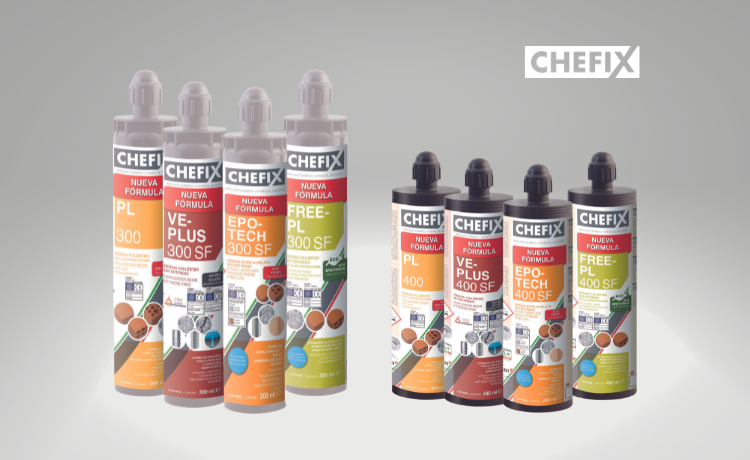What are chemical anchors and how are they used?
Chemical anchors are a very useful solution for fastening elements to hollow or solid materials such as bricks, concrete, stone, porous concrete, etc.

What are chemical anchors?
Chemical anchors are a very useful solution to fix elements to hollow or solid materials such as, for example, bricks, concrete, stone, porous concrete, etc. This is achieved through the application of a resin inside a hole in which a stud is inserted to withstand high loads. This product is composed of the resin itself and a product called catalyst, which are mixed inside the mixing nozzle thanks to its inner spiral, causing both components to react and perform their task.
Types of chemical anchors
There are different resin compounds and we will use one or another according to the application we want to carry out and depending on the material and the load that the anchor has to support:
Polyester Resin (PL): This resin is especially indicated for application in solid brick, semi-hollow brick, hollow blocks and hollow concrete blocks. In addition, it withstands masonry loads up to 595 kg and concrete loads up to 4.600 kg.
Styrene-Free Polyester Resin (FREE-PL): This resin is suitable for the same materials as the normal polyester resin, including concrete, and withstands higher working loads: 700 kg in masonry and 8.900 kg in concrete.
Styrene-free Epoxy Acrylate Resin (EPO-TECH): The main advantage of this product is that it can be applied on damp or slightly wet surfaces. It is suitable for solid brick, concrete, cellular concrete and wood, and withstands working loads of up to 9.500 kg in concrete.
Styrene-free Vinyl Ester Resin (VE-PLUS): This type of resin is very complete, since it can be used in all the materials mentioned above (solid bricks, semi-hollow bricks, hollow blocks, hollow concrete blocks, concrete, cellular concrete, cracked concrete and wood). It withstands working loads of 15.000 kg in concrete and can also be used on water-covered surfaces, is insulating and has a fire resistance of 120 minutes.
How are chemical anchors used?
The chemical anchors are very easy to install, just follow these 5 steps:
1. Drill the surface: The first step to follow is to drill the surface where you want to place the chemical anchor. Remember to choose your anchor according to the material where you want to apply it.
2. Clean the residues generated from the perforation: Once the perforation is ready, it is very important to clean it and remove all the excess residue to ensure the perfect adhesion of the product, for this you can use a blowing pump or a steel brush.
3. Introducing the resin: Something very important to keep in mind before introducing the resin into the borehole is that 5 to 10 centimeters of product should be discarded on a cloth or paper until the mixture adopts a uniform color and a consistent texture. This will indicate that the two products (resin and catalyst) are well mixed and ready to apply. Depending on the material to be drilled it will be advisable to use one block or another. If the material is hollow, a nylon sleeve should be used in the hole, as it facilitates the spreading of the applied resin. If the drilled material is solid, it is not necessary to use a nylon sleeve. In this case, the mixture can be introduced directly into the hole.
4. Insert the dowel or the chosen fastener: Once the resin has been inserted into the hole (with or without a nylon sleeve), the fastening element (screw, rod, stud, etc.) must be inserted. It is recommended to insert the fastening element by turning it slightly to ensure that the resin adheres perfectly to its surface. It should also be borne in mind that the resin has a margin of only a few minutes before drying, so the handling time is reduced and it is advisable to insert the fastener immediately after filling the hole.
5. Curing time: Each resin has a different curing time, so it is recommended to read the manufacturer's instructions carefully and comply with the established time.
And that's all! We hope you liked it and, if you have any doubts or questions, do not hesitate to contact us by clicking here.